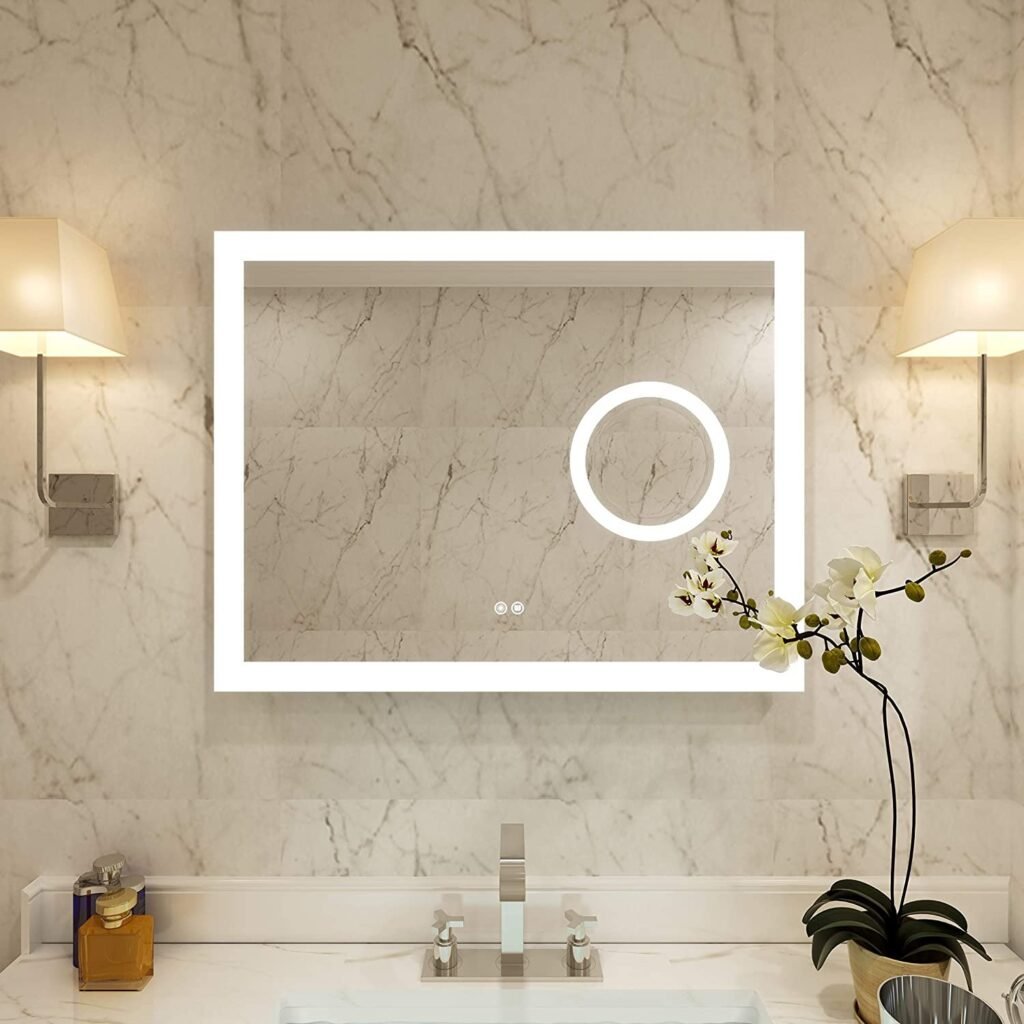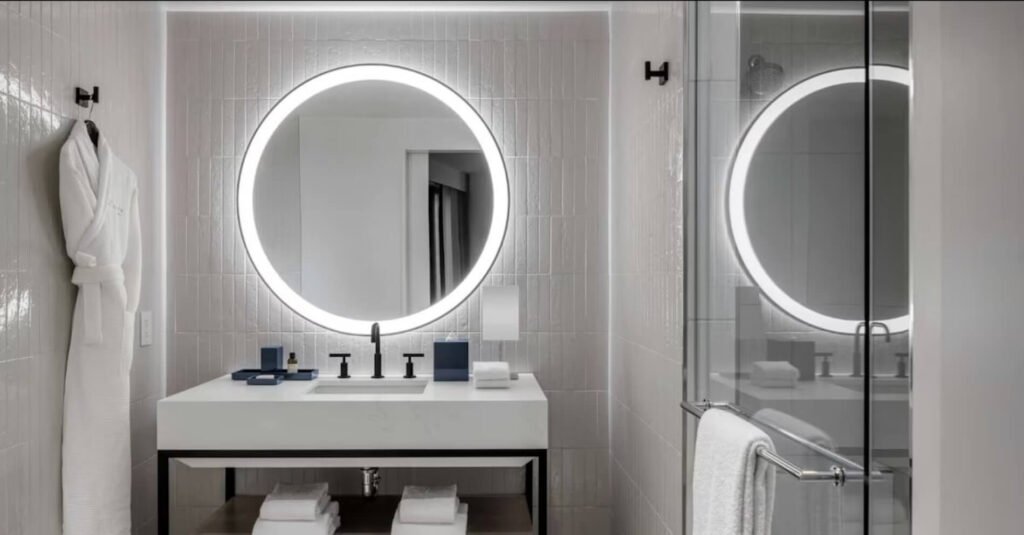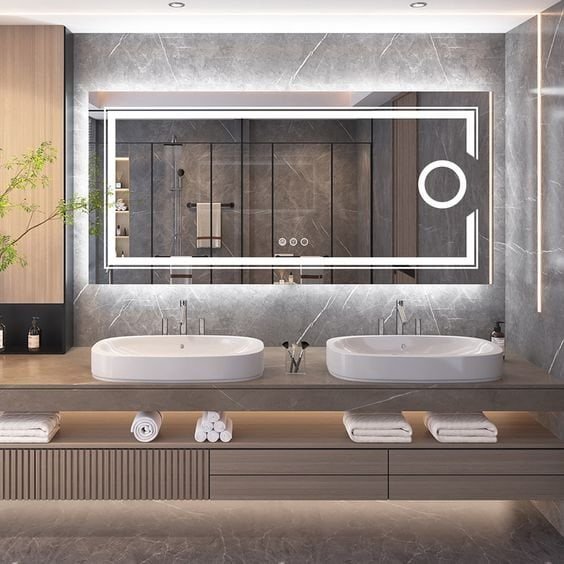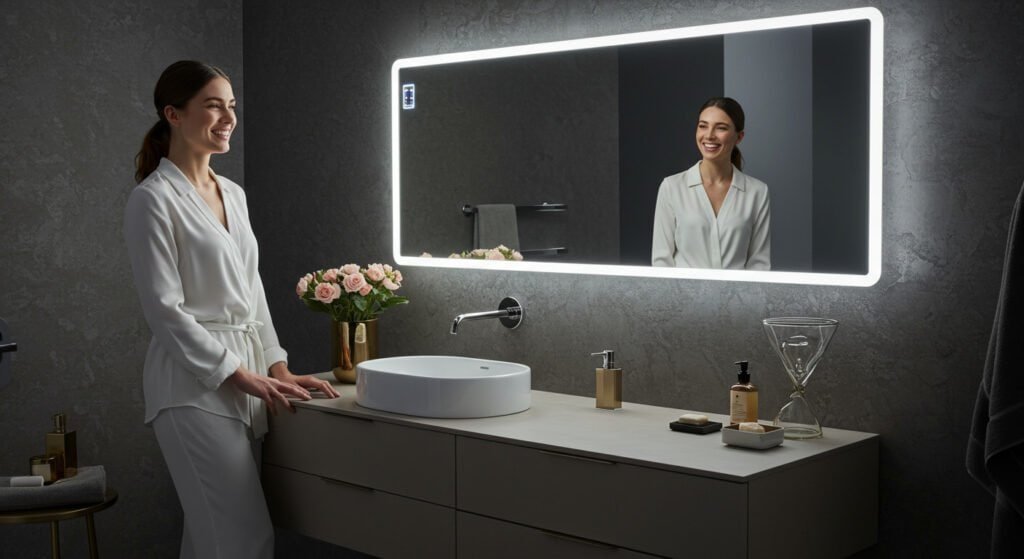|
Conseguir tu Trinidad Audio jugador listo...
|
Con el tiempo, dust and dirt can accumulate and cause bathroom mirrors to reflect, interrupting your daily routine. So how often should we clean mirrors in our daily lives?
To maintain a clear, spotless surface, clean your espejo del baño at least once a week. Regular maintenance enhances visibility and prolongs the mirror’s lifespan, ensuring it remains a functional and attractive feature.
Let’s delve into the reasons why it is important to clean them regularly and discuss the best way to clean your bathroom mirror.

Why Is It Important to Clean Your Bathroom Mirror Regularly?
A bathroom mirror is a central part of your daily grooming ritual. Keeping it clean maintains its clarity and brightness, which in turn affects the overall feel of your bathroom.
If you neglect your mirror, soap scum, water spots, and even mold can form, creating health hazards. Regular cleaning will help eliminate these problems and create a healthier environment.
A clean mirror not only looks good, but it also provides a clear reflection, which is important when shaving, Aplicando maquillaje, or styling your hair. Keeping your mirror clean enhances your daily self-care routine and makes these tasks more enjoyable.
What Is the Best Cleaning Frequency?
The frequency of cleaning will depend on how often the mirror is used and the environment, but as a general rule, you should clean your mirror at least once a week.
For households with high humidity or larger families, daily cleaning or cleaning after each use may be necessary to remove the moisture that causes mold.
If your bathroom use involves water, consider giving it a quick wipe down daily. This small investment of time will pay off in maintaining the clarity and cleanliness of your mirror.
How to Clean Your Bathroom Mirror Effectively?
Cleaning a bathroom mirror properly requires the right tools and the right technique. Using harsh chemicals can damage the surface, so it is important to choose your cleaning agents wisely.
For best results, use a microfiber cloth and a mild glass cleaner or a homemade solution of equal parts vinegar and water. This method will prevent streaking and leave your mirror spotless.
To clean your mirror properly, follow these steps:
- Gather Your Supplies:
Begin by gathering your cleaning supplies. You will need a microfiber cloth, a mild glass cleaner or vinegar-water solution, and a spray bottle. Make sure your cloth is clean and free of dust or debris. - Prepare the Cleaning Solution:
If you are using a homemade solution, mix equal parts vinegar and water in the spray bottle. This natural cleaner is effective and safe for your mirror. - Spray the Cloth, Not the Mirror:
To prevent excess moisture from seeping into the edges of the mirror, spray your solution on the microfiber cloth instead of directly on the mirror. This will prevent damage to the backing. - Wipe in Circular Motions:
Start at the top of the mirror and work your way down. Use circular motions to cover the entire surface evenly. Begin in one corner and work your way across the mirror. - Tackle Tough Spots:
For stubborn spots or stains, let the solution sit for a minute before wiping. This extra time can help break down the grime and make it easier to clean. - Buff to Shine:
After cleaning, use a dry part of the microfiber cloth to buff the mirror. This will enhance the shine and remove any remaining streaks, leaving you with a clear mirror. - Regular Maintenance:
To keep your mirror looking its best, add this cleaning routine to your weekly chores. Regular maintenance will prevent buildup and make cleaning easier in the future.
By following these steps, you can have a crystal-clear bathroom mirror that will enhance the functionality and beauty of your space.

How to Prevent Mirror Damage?
Prevention is the key. Protecting your bathroom mirror from damage will keep it in good condition. Avoid using abrasive materials that can scratch the surface. Uso suave, lint-free cloths and mild cleaners.
Consider a protective backing or sealant to prevent moisture. Check regularly for edge deterioration and address problems immediately to prevent further damage.
How to Prevent Steaming on the Mirror?
Foggy mirrors can be annoying, especially in a steamy bathroom. Luckily, there are ways to prevent this. Applying a de-fogging spray or a thin layer of shaving cream creates a barrier that reduces fogging. Installing a bathroom fan can also help reduce humidity levels.
Running hot water and leaving the bathroom door ajar can help air circulate and reduce steam. For a more permanent solution, consider a heated mirror or one with built-in de-fogging technology.
How Often Does the Average Person Clean Their Bathroom?
Cleaning habits vary greatly. On average, most people clean their bathroom mirrors once a week. This frequency may change depending on the size of your family, how often the bathroom is used, and your personal cleaning habits.
Surveys indicate that many people overlook cleaning their mirrors while cleaning their bathrooms. Setting reminders or incorporating mirror cleaning into your routine will help keep your mirrors clean.
How to Maintain Your Espejo?
Proper maintenance is important to keep your bathroom mirror in good working order and looking good. Regularly inspect and clean it. Check for corrosion around the edges and clean gently to prevent further damage.
Applying a protective coating can help protect your mirror from moisture and the environment. Make sure you have good ventilation to reduce humidity and condensation, which can shorten the life of your mirror.
Why Do Bathroom Mirrors Turn Black?
“Black edges” on mirrors can happen over time from moisture getting behind the mirror. This can lead to rusting or the backing deteriorating.
Keep your mirror dry and avoid getting it wet. Caulking around the edges can prevent moisture from getting behind the mirror. Regular cleaning will also help prevent this problem.
Why Are My Mirrors Smeared After Cleaning?
Streaks after cleaning can be frustrating. Smudges on mirrors are often caused by too much cleaning solution or not drying properly. Use less cleaner and a clean microfiber cloth to avoid streaks. Buff the mirror with a dry cloth to make it shine.

Why Are My Mirrors Cloudy After Cleaning?
Cloudy mirrors can be confusing after you clean them. This is often caused by leftover cleaning products or hard water residue. Using distilled water for cleaning will prevent mineral deposits. A vinegar rinse after cleaning can help remove residue.
Can You Use Dawn Dish Soap on Mirrors?
Is Dawn dish soap good for mirrors? Sí, diluted Dawn can clean mirrors, but make sure you rinse it off well so there is no residue.
Mix a few drops with water in a spray bottle, spray it on the mirror, and use a microfiber cloth for the best results. Use sparingly because soap can leave a film if it is not rinsed well.
What Is the Difference Between Simple Mirrors and Espejos LED?
There are big differences between traditional mirrors and LED mirrors. LED mirrors have better lighting features and can do things like touch controls and adjustable brightness.
For a modern, versatile option, LED mirrors will enhance your bathroom experience with better lighting and features like defogging and built-in speakers.
How to Clean an LED Lighted Bathroom Mirror?
Cleaning an LED mirror requires special care to avoid damaging the electrical components. Using the right techniques will keep both the mirror and the lighting features in great condition.
Use a damp cloth with a mild cleaning solution, and avoid harsh chemicals that could seep into the casing and cause damage.
To clean your LED lighted bathroom mirror effectively, follow these steps:
- Gather Your Cleaning Supplies:
Gather your supplies, including a microfiber cloth, a mild cleaning solution (such as a vinegar and water mix or a non-abrasive glass cleaner), and a spray bottle. Make sure your microfiber cloth is clean to avoid scratching the mirror. - Apagar el poder:
Before you begin cleaning, turn off the power to the LED mirror. This step is important to avoid any electrical hazards and to keep you safe while cleaning. - Prepare the Cleaning Solution:
If you choose to use a homemade solution, mix equal parts vinegar and water in a spray bottle. This solution will clean the mirror without harming the components. - Dampen the Cloth:
Spray your cleaning solution lightly on the microfiber cloth. Do not soak it, as too much moisture can seep into the edges of the mirror and damage the electrical components. - Gently Wipe the Mirror:
Using the damp cloth, gently wipe the mirror. Start at the top and work your way down, using smooth, circular motions to clean the mirror evenly and avoid streaks. - Clean Around the Edges:
Pay special attention to the edges of the mirror where moisture can collect. Use a slightly damp cloth to carefully wipe the edges, making sure no excess liquid gets inside. - Buff the Surface:
After cleaning, use a dry part of the microfiber cloth to gently buff the mirror. This will help remove any remaining moisture and make the mirror shine. - Check the Lighting Features:
Once the mirror is clean and dry, turn the power back on. Test the LED lighting features to make sure they are working correctly and that no moisture has affected the electrical components. - Establish a Regular Cleaning Routine:
Add cleaning your LED mirror to your regular bathroom cleaning routine. Keeping a regular schedule will help prevent buildup and keep your mirror clean and working well.
By following these steps, you can keep your LED lighted bathroom mirror sparkling clean and ensure it continues to be a stylish and functional element in your bathroom.

How Long Do LED Bathroom Mirrors Last?
LED mirrors are durable and a good investment. Generalmente, LED mirrors last between 20,000 y 50,000 horas, depending on how often they are used and the quality of the mirror. Proper maintenance and choosing high-quality mirrors from reputable manufacturers can help your mirror last longer.
Can I Use Windex on an LED Mirror?
Windex is a popular choice for cleaning mirrors, but is it safe to use on LED mirrors? It is best to avoid using Windex on LED mirrors because it contains ammonia, which can damage the components. Instead, use a mild cleaner that is specifically made for mirrors to keep your mirror working and looking good.
Regularly cleaning your bathroom mirror is important for hygiene and aesthetics, and it is recommended that you clean it at least once a week.
Using the right techniques and taking preventive measures will help you see better, keep your mirror looking good longer, and maintain a clear reflection for your daily grooming routine.
By addressing issues such as fogging, abundancia de nubes, and damage, you can keep your mirror functional and looking good in your bathroom. If you have any other questions or better answers to the above questions, por favor Contáctenos and we can discuss it together.





